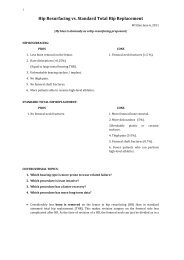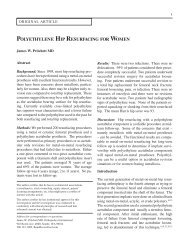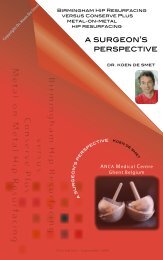Hip and Knee Arthroplasty - Surface Hippy Guide to Hip Resurfacing
Hip and Knee Arthroplasty - Surface Hippy Guide to Hip Resurfacing
Hip and Knee Arthroplasty - Surface Hippy Guide to Hip Resurfacing
You also want an ePaper? Increase the reach of your titles
YUMPU automatically turns print PDFs into web optimized ePapers that Google loves.
increasing age. Those individuals aged less than<br />
55 years at the time of surgery have a five year<br />
cumulative percent revision of 17.0%. The<br />
remaining three age groups, 55-64, 65-74 <strong>and</strong> 75<br />
years <strong>and</strong> older have a five year cumulative<br />
percent revision of 13.0%, 12.3% <strong>and</strong> 7.0%<br />
respectively (Tables KP8 <strong>and</strong> KP9).<br />
Males have over twice the risk of revision<br />
compared <strong>to</strong> females, revisions per 100 observed<br />
component years for males is 4.6 compared <strong>to</strong><br />
2.7 for females. The five year cumulative<br />
percent revision for males is 21.3% <strong>and</strong> for<br />
females is 11.7% (Tables KP10 <strong>and</strong> KP11).<br />
There is considerable variation in outcome<br />
depending on the type of prosthesis used. The<br />
revisions per 100 observed component years for<br />
all nine trochlear prostheses are provided in<br />
Table KP6. Of the most commonly used<br />
prostheses the RBK <strong>and</strong> Avon have the lowest<br />
rate of revision (1.8 <strong>and</strong> 2.1 respectively) (Table<br />
KP6). The RBK however has fewer procedures<br />
<strong>and</strong> has not been followed up for as long as the<br />
Avon. The prosthesis with the lowest five year<br />
cumulative percent revision is the Avon (9.5%)<br />
(Table KP7).<br />
Patella/Trochlear <strong>Knee</strong> Replacement<br />
with a higher than anticipated Revision<br />
Rate<br />
The LCS has been identified by the Registry as<br />
having a higher than anticipated rate of revision<br />
compared <strong>to</strong> all other patella/trochlear<br />
procedures with 4.98 revisions per 100 observed<br />
component years (Hazard Ratio adjusted for age<br />
<strong>and</strong> sex (Adj HR)=2.05; 95% CI (1.26, 2.94)<br />
p=0.001) (Table KP24). The LCS<br />
patella/trochlear prosthesis has a five year<br />
cumulative percent revision of 23.0% (Table<br />
KP25 <strong>and</strong> Figure KP10).<br />
Unicompartmental <strong>Knee</strong> Replacement<br />
This year the Registry is reporting the analysis of<br />
25,607 primary unicompartmental knee<br />
replacements <strong>to</strong> the 31 st December 2007. Almost<br />
all unicompartmental procedures have been<br />
undertaken for osteoarthritis (98.8%).<br />
Usage<br />
Unicompartmental knee replacement continues <strong>to</strong><br />
decrease as a proportion of all primary knee<br />
replacements. In 2007 unicompartmental<br />
procedures accounted for 9.7% of all knee<br />
procedures compared <strong>to</strong> 10.7% in 2006 <strong>and</strong><br />
14.6% in 2003 (Figure KG3). The <strong>to</strong>tal number<br />
of primary unicompartmental knee replacements<br />
performed in 2007 was 3,448, representing a<br />
continual decline from 4,102 procedures<br />
performed in 2003 (Table KP12).<br />
Types of Prostheses Used<br />
The Registry has recorded the use of 23 different<br />
types of unicompartmental knee replacement<br />
prostheses, 20 of which were used in 2007. This<br />
is an increase from 18 different prostheses used<br />
in 2006. The ten most commonly used<br />
prostheses accounted for 88.7% of all<br />
unicompartmental knee procedures in 2007. The<br />
Oxford 3 prosthesis continues <strong>to</strong> be the most<br />
frequently used, however as previously reported<br />
its use continues <strong>to</strong> decline reducing from 33.3%<br />
of all procedures in 2003 <strong>to</strong> 27.9% in 2007. The<br />
ZUK unicompartmental knee prosthesis was first<br />
used in 2005 <strong>and</strong> is now the second most used<br />
prosthesis (12.9% of all procedures in 2007).<br />
Apart from the Unix, which has increased slightly<br />
in numbers from 2006, most other<br />
unicompartmental prostheses have declined in<br />
use (Table KP12 <strong>and</strong> Figure KP4).<br />
Changes in use with Gender <strong>and</strong> Age<br />
The continued decline in use of this procedure is<br />
evident in both males <strong>and</strong> females <strong>and</strong> all age<br />
groups (Tables KP13 <strong>and</strong> KP14).<br />
Unicompartmental knee replacement is most<br />
commonly undertaken in the 55-64 year age<br />
group (34.5% in 2007) followed by the 65-74<br />
years (30.5% in 2007). Over 20% of individuals<br />
are 75 years <strong>and</strong> older <strong>and</strong> less than 15% are<br />
less than 55 years of age at the time of surgery<br />
(Table KP14).<br />
Fixation<br />
Most unicompartmental knee replacements<br />
recorded by the Registry have both cemented<br />
tibial <strong>and</strong> femoral components (89.7%). The<br />
proportion of uncemented unicompartmental<br />
knee replacements has slowly increased from<br />
8.3% in 2003 <strong>to</strong> 13.4% in 2007. Hybrid fixation<br />
(either the tibial or femoral component<br />
cemented) has remained unchanged, accounting<br />
for 0.9% of all unicompartmental knee<br />
replacements (Table KP15 <strong>and</strong> Figure KP5).<br />
Considerable state <strong>and</strong> terri<strong>to</strong>ry variation<br />
continues with 40.3% cementless fixation in<br />
Vic<strong>to</strong>ria, an increase from 35.6% in 2006, <strong>and</strong><br />
predominantly cement fixation in Western<br />
Australia (98.3%). South Australia continues <strong>to</strong><br />
be the only state where hybrid fixation is used <strong>to</strong><br />
any extent (5.2%) (Figure KP5).<br />
Outcomes of Unicompartmental <strong>Knee</strong><br />
Replacement<br />
At one year, the cumulative percent revision for<br />
unicompartmental knee replacement is 2.3% <strong>and</strong><br />
at seven years is 12.1%. This is almost three<br />
times the seven year cumulative percent revision<br />
of primary <strong>to</strong>tal knee replacement (4.3%) (Table<br />
KG5).<br />
118






